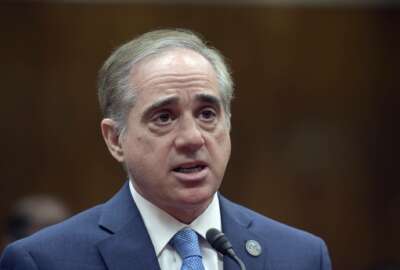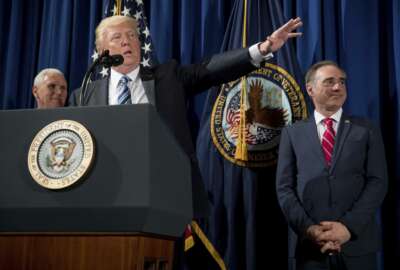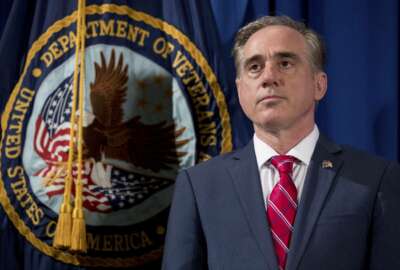
As the Choice program runs out of money this year, VA reiterates need for a redesign
The Veterans Affairs Department once again needs congressional authority to transfer funds from one account to another to keep the Veterans Choice Program runni...
The Veterans Affairs Department is quickly running out of money in its Choice program account, one of several funding streams VA uses to pay for veterans to receive community health care.
This development with the Choice program is only the latest of a series of pain points for the department and Congress. Yet VA Secretary David Shulkin said it only emphasizes the urgency of redesigning and simplifying the Choice program in the near future.
The short term fix is a relatively simple one: the department needs congressional authorization to transfer money from one account to another.
“This is the situation that we’ve described before, where for a single purpose of providing care in the community, we have two checking accounts,” Shulkin said during a June 14 hearing before the Senate Veterans Affairs Committee on the VA’s fiscal 2018 budget. “I will tell you, I wish it were easier than it is. We have to figure out how to balance these two checking accounts at all times, and obviously, it’s not a science, it’s an art. We’re having difficulty with that once again.”
When Shulkin first testified before the House Veterans Affairs Committee in the beginning of March, the account had $2 billion. When the President signed legislation into law a month and a half later allowing VA to use remaining funds to carry out the Choice program until the end of fiscal 2017, the account had $1.5 billion.
Now, the Choice account has $821 million, Shulkin said.
“We have enough money to be able to make sure that all veterans will get the care that they need,” he said. “We need your help to figure the best solution about how to get more money into the Choice account.”
The emergency isn’t over funding. VA said technically it has enough appropriations to continue to pay for the Choice program for the rest of the fiscal year. But VA will transfer about $626 million from a community care account to continue to pay for the Choice program this year. However, the department had assumed it would carry that $626 million to next year’s 2018 budget. If Congress authorizes the transfer this year, VA will have a hole in its 2018 budget.
“It’s not just a matter of transferring money back and forth,” Sen. Jerry Moran (R-Kan.) said. “It’s a matter of making sure that Choice is viable, so that the network stays in place.”
This expected budget short fall has some veterans service organizations concerned.
“Right now, VA could be staring at a huge hole in its budget for 2018,” Carl Blake, associate executive director of government relations for Paralyzed Veterans for America. “We’ve expressed this to the appropriators. … None of these questions are answered, yet the VA is left with billions of dollars in unanswered questions. It’s not enough to simply say, we have enough money; we can move it around. That’s not true.”
Many VSOs have expressed their concerns with the President’s 2018 budget proposal for the department, and VA’s approach to budgeting major upcoming projects that haven’t been authorized or appropriated yet.
Shulkin’s decision to abandon VistA and adopt the same commercial, off-the-shelf electronic health record as the Defense Department has earned praise from many lawmakers, but VSOs seem more skeptical. The project doesn’t yet have a price tag, and the 2018 budget cuts VA IT funding by $215 million.
Shulkin offered a glimpse of the department’s proposal to redesign the Choice program last week. Under the Veterans’ Coordinated Access Rewarding Experience (CARE) Program, veterans would no longer access community providers based on a set of arbitrary, administrative rules, Shulkin said.
VA would administer the CARE program under one common funding account.
“The Choice program has been difficult to administer, difficult to understand and very complex,” Shulkin said. The CARE program, he said, would prevent the department from having the same challenges.
Based on the initial debate, the coming decision won’t be an easy one. Some senators and veterans service organizations are concerned VA’s approach will spark an eventual shift toward privatizing veterans health care, and they fear it’s a signal of the beginning of the end for what many see as a core function of the department.
Appeals backlog
The Senate committee will discuss the VA Appeals Improvement and Modernization Act of 2017 at a legislative hearing Thursday. The bill includes the same provisions that VA negotiated with veterans service organizations and other stakeholders during a series of meetings on the topic last year, including three different paths that veterans could take to pursue their appeal. One of those paths gives veterans the option to waive their right to a hearing or the ability to submit new evidence to get a faster appeal decision.
Yet the legislation does not provide a fix that would address the bulk of the 470,000 claims in VA’s appeals backlog. At the department’s current pace and funding level, Shulkin said VA won’t be able to fully resolve those legacy claims for nearly a decade.
“We do not have a plan to make significant progress on those,” he said. “We’re going to have to whittle away at them. The budget this year will add 142 more staff to the Board [of Veterans Appeals]. That will allow us to make incremental progress. But to deal with the backlog, we’re looking at 2026 before we’ve dealt with the backlog.”
VA could request more funding dedicated to the backlog — but at a hefty price. Shulkin estimated it would cost the department $800 million more to resolve the backlog before 2026.
Copyright © 2024 Federal News Network. All rights reserved. This website is not intended for users located within the European Economic Area.
Nicole Ogrysko is a reporter for Federal News Network focusing on the federal workforce and federal pay and benefits.
Follow @nogryskoWFED
Related Stories





